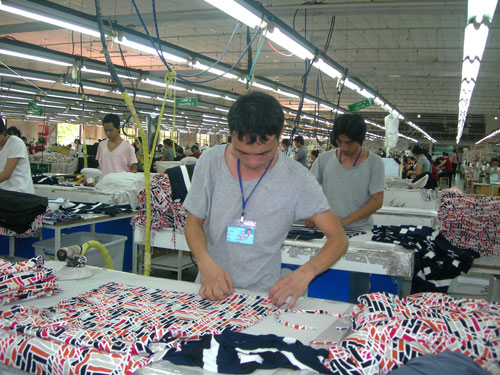Challenges and opportunities for Binh Duong’s garment-textile industry
Garment and textile is one of Binh Duong’s industries with strong growth. According to statistics from provincial Garment and Textile Association, the whole province is now home to 357 garment and textile enterprises, generating jobs for hundreds of laborers. The industry has overtime made great contributions to the local economic growth, but now faces challenges…
Efforts to overcome crisis
In the first five months of 2012, Binh Duong’s garment and textile industry reached US$600mln in export turnover, increasing by 0.1% compared to the same period last year and accounting for 13.5% of the province’s total export turnover.
 Garment
products being manufactured for export The industry’s main export markets are still the US, EU, South
Korea and Japan.
Most of enterprises in the industry have got orders for export till mid 2012.
Garment
products being manufactured for export The industry’s main export markets are still the US, EU, South
Korea and Japan.
Most of enterprises in the industry have got orders for export till mid 2012.
Le Hong Phoa, chairman of provincial Garment and Textile Association said that although the world’s economy has faced difficulties, the domestic garment and textile industry has still gained high growth.
One of the reasons for the growth is the fact that domestic enterprises have created faith among clients. Upon this, the industry’s export growth in traditional markets such as the US, EU and Japan has still achieved instability. Some new markets like South Korea, Canada…have also contributed to the growth of the industry.
Another reason is that the Government and the Vietnam Garment and Textile Association have taken many measures to help enterprises in the industry to deal with difficulties in the context of the current economic downturn.
Facing challenges
In early 2012, garment and textile was one of Binh Duong’s top industries in export turnover. But now, the industry’s exports to the US, Japan and EU see considerable reduction.
The reason lies in the fact that the EU importers have shifted the orders from Vietnam to Cambodia, Laos and Bangladesh so as to avoid import tax rate of 10 percent in Vietnam and get entitled to MFN tariff rate of 0 percent applied to the latter to save the cost.
The global economic crisis has also made purchasing power for garment and textile products in the above markets go down. As predicted, garment and textile exports to EU in the second half of 2012 will reduce by 10%-20% compared to the same period last year.
Whilst, in the domestic market, garment and textile enterprises now face more difficulties for change, particular in capital and consumption market.
To deal with the above challenges, according to Mr.Phoa, garment and textile enterprises need to cut down on costs, improve management methods and manufacture products with higher added value in order to create competitive advantages and seek ways to get access to the market for better development.
Reported by Bao Anh-Translated by K.T

